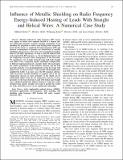Influence of Metallic Shielding on Radio Frequency Energy-Induced Heating of Leads With Straight and Helical Wires: A Numerical Case Study
Author(s)
Kozlov, Mikhail; Kainz, Wolfgang; Daniel, Luca
DownloadKozlov_T-MTT_2020_08964574.pdf (3.997Mb)
Open Access Policy
Open Access Policy
Creative Commons Attribution-Noncommercial-Share Alike
Terms of use
Metadata
Show full item recordAbstract
Heating induced by radio frequency (RF) energy may appear in tissues near implants located in a human subject undergoing magnetic resonance imaging examination. Lead shielding was proposed to reduce such heating below dangerous levels. In this article, we employed 3-D electromagnetic (EM) and thermal co-simulations to quantify the effectiveness of metallic shielding in the presence of two large sets of nonuniform incident fields at 128 MHz. Specifically, we used a lead EM model (LEM) and computed the RF responses, i.e., the net dissipated power and net temperature increase, above background, at the electrodes. We considered a set of single electrode leads with both straight and helical wires, comparing regular unshielded configurations to different implementations of a metallic shield. The lead length, the relative permittivity of the insulator material, and the lead electrode geometry were all independently varied. For leads with helical wires we observed that: 1) the metallic shield significantly modified the LEM; 2) in most cases, the RF responses substantially increased if metallic shielding was applied; and 3) the net temperature increase in close proximity to the shield can be substantially higher than the net temperature increase in close proximity to the lead electrode. Leads with helical and straight wires exhibited significantly different behavior. Using the results obtained from generic straight wire leads to predict the results for leads with helical wires can be significantly misleading.
Date issued
2020-02Department
Massachusetts Institute of Technology. Department of Electrical Engineering and Computer ScienceJournal
IEEE Transactions on Microwave Theory and Techniques
Publisher
Institute of Electrical and Electronics Engineers (IEEE)
Citation
Kozlov, Mikhail et al. "Influence of Metallic Shielding on Radio Frequency Energy-Induced Heating of Leads With Straight and Helical Wires: A Numerical Case Study." IEEE Transactions on Microwave Theory and Techniques 68, 2 (February 2020): 509 - 515. © 2020 IEEE
Version: Author's final manuscript
ISSN
0018-9480
1557-9670